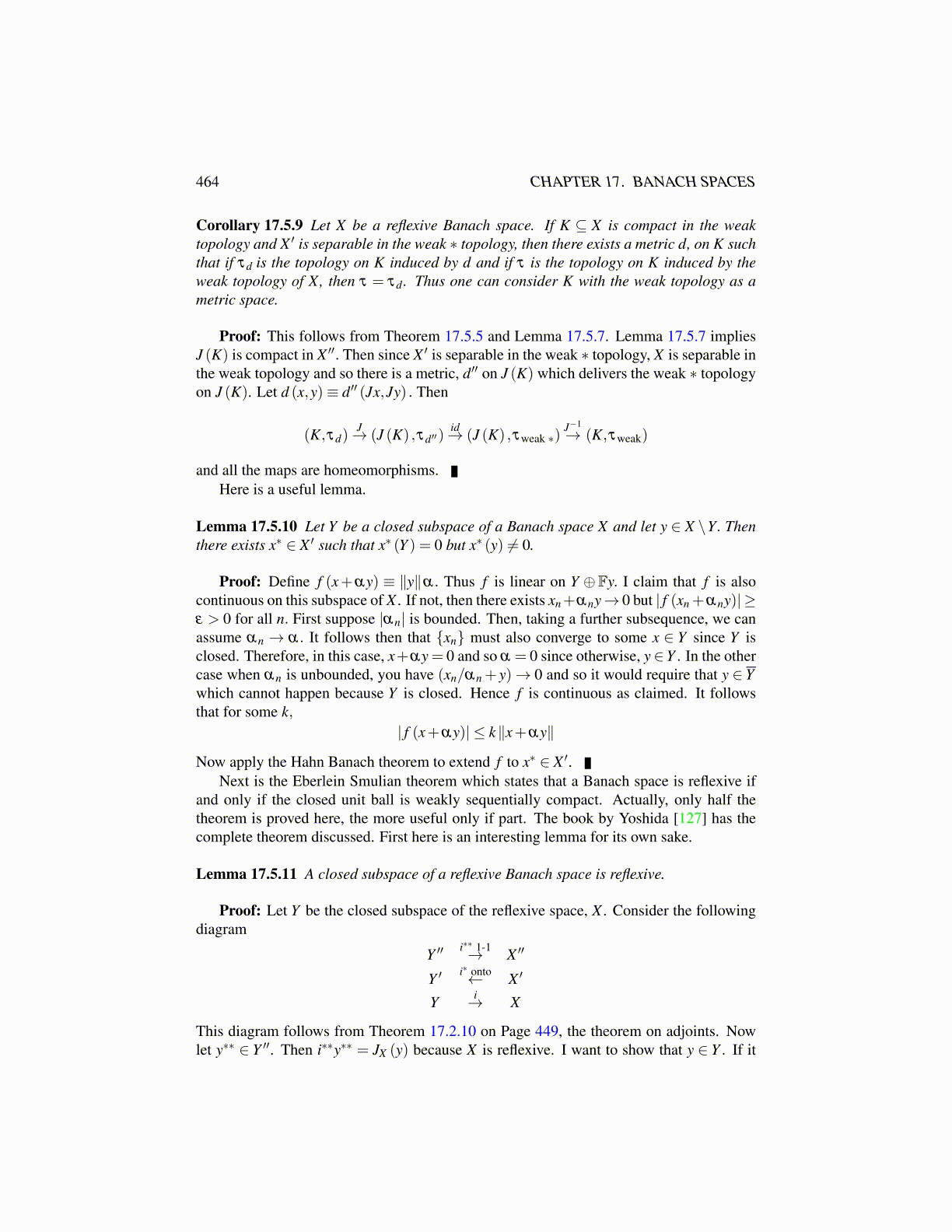
464 CHAPTER 17. BANACH SPACES
Corollary 17.5.9 Let X be a reflexive Banach space. If K ⊆ X is compact in the weaktopology and X ′ is separable in the weak ∗ topology, then there exists a metric d, on K suchthat if τd is the topology on K induced by d and if τ is the topology on K induced by theweak topology of X, then τ = τd . Thus one can consider K with the weak topology as ametric space.
Proof: This follows from Theorem 17.5.5 and Lemma 17.5.7. Lemma 17.5.7 impliesJ (K) is compact in X ′′. Then since X ′ is separable in the weak ∗ topology, X is separable inthe weak topology and so there is a metric, d′′ on J (K) which delivers the weak ∗ topologyon J (K). Let d (x,y)≡ d′′ (Jx,Jy) . Then
(K,τd)J→ (J (K) ,τd′′)
id→ (J (K) ,τweak ∗)J−1→ (K,τweak)
and all the maps are homeomorphisms.Here is a useful lemma.
Lemma 17.5.10 Let Y be a closed subspace of a Banach space X and let y ∈ X \Y. Thenthere exists x∗ ∈ X ′ such that x∗ (Y ) = 0 but x∗ (y) ̸= 0.
Proof: Define f (x+αy) ≡ ∥y∥α. Thus f is linear on Y ⊕Fy. I claim that f is alsocontinuous on this subspace of X . If not, then there exists xn+αny→ 0 but | f (xn +αny)| ≥ε > 0 for all n. First suppose |αn| is bounded. Then, taking a further subsequence, we canassume αn → α. It follows then that {xn} must also converge to some x ∈ Y since Y isclosed. Therefore, in this case, x+αy = 0 and so α = 0 since otherwise, y∈Y . In the othercase when αn is unbounded, you have (xn/αn + y)→ 0 and so it would require that y ∈ Ywhich cannot happen because Y is closed. Hence f is continuous as claimed. It followsthat for some k,
| f (x+αy)| ≤ k∥x+αy∥
Now apply the Hahn Banach theorem to extend f to x∗ ∈ X ′.Next is the Eberlein Smulian theorem which states that a Banach space is reflexive if
and only if the closed unit ball is weakly sequentially compact. Actually, only half thetheorem is proved here, the more useful only if part. The book by Yoshida [127] has thecomplete theorem discussed. First here is an interesting lemma for its own sake.
Lemma 17.5.11 A closed subspace of a reflexive Banach space is reflexive.
Proof: Let Y be the closed subspace of the reflexive space, X . Consider the followingdiagram
Y ′′ i∗∗ 1-1→ X ′′
Y ′ i∗ onto← X ′
Y i→ X
This diagram follows from Theorem 17.2.10 on Page 449, the theorem on adjoints. Nowlet y∗∗ ∈ Y ′′. Then i∗∗y∗∗ = JX (y) because X is reflexive. I want to show that y ∈ Y . If it